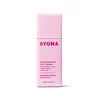What's inside
What's inside
 Key Ingredients
Key Ingredients

 Benefits
Benefits

 Concerns
Concerns

 Ingredients Side-by-side
Ingredients Side-by-side

Althaea Officinalis Root Extract
Skin ConditioningAscorbyl Palmitate
AntioxidantCaprylhydroxamic Acid
Dicaprylyl Carbonate
EmollientDicaprylyl Ether
EmollientGlycerin
HumectantGlyceryl Caprylate
EmollientMagnesium Stearate
Cosmetic ColorantMica
Cosmetic ColorantNeopentyl Glycol Diheptanoate
EmollientOryza Sativa Bran Extract
Skin ConditioningPhyllanthus Emblica Fruit Extract
HumectantPolyester-7
Skin ConditioningPolyglutamic Acid
Skin ConditioningPolyglycerin-6
HumectantPolyglyceryl-6 Polyhydroxystearate
EmulsifyingPolyglyceryl-6 Polyricinoleate
EmulsifyingPotassium Sorbate
PreservativeSodium Benzoate
MaskingSodium Chloride
MaskingSodium Hyaluronate
HumectantSqualane
EmollientStearic Acid
CleansingCI 77891
Cosmetic ColorantTocopherol
AntioxidantTriethoxycaprylylsilane
Trihydroxystearin
Skin ConditioningTrioctyldodecyl Citrate
EmollientWater
Skin ConditioningCI 77491
Cosmetic ColorantCI 77492
Cosmetic ColorantCI 77499
Cosmetic ColorantAlthaea Officinalis Root Extract, Ascorbyl Palmitate, Caprylhydroxamic Acid, Dicaprylyl Carbonate, Dicaprylyl Ether, Glycerin, Glyceryl Caprylate, Magnesium Stearate, Mica, Neopentyl Glycol Diheptanoate, Oryza Sativa Bran Extract, Phyllanthus Emblica Fruit Extract, Polyester-7, Polyglutamic Acid, Polyglycerin-6, Polyglyceryl-6 Polyhydroxystearate, Polyglyceryl-6 Polyricinoleate, Potassium Sorbate, Sodium Benzoate, Sodium Chloride, Sodium Hyaluronate, Squalane, Stearic Acid, CI 77891, Tocopherol, Triethoxycaprylylsilane, Trihydroxystearin, Trioctyldodecyl Citrate, Water, CI 77491, CI 77492, CI 77499
Water
Skin ConditioningGlycerin
HumectantCaprylic/Capric Triglyceride
MaskingPentaerythrityl Tetraethylhexanoate
EmollientNiacinamide
SmoothingCeramide NP
Skin ConditioningCholesterol
EmollientPhytosphingosine
Skin ConditioningPolyglyceryl-3 Methylglucose Distearate
EmulsifyingStearic Acid
CleansingOleic Acid
EmollientLactic Acid
BufferingTromethamine
BufferingCamellia Sinensis Leaf Extract
AntimicrobialHydroxyacetophenone
AntioxidantCetearyl Alcohol
EmollientCarbomer
Emulsion StabilisingXanthan Gum
Emulsifying1,2-Hexanediol
Skin ConditioningWater, Glycerin, Caprylic/Capric Triglyceride, Pentaerythrityl Tetraethylhexanoate, Niacinamide, Ceramide NP, Cholesterol, Phytosphingosine, Polyglyceryl-3 Methylglucose Distearate, Stearic Acid, Oleic Acid, Lactic Acid, Tromethamine, Camellia Sinensis Leaf Extract, Hydroxyacetophenone, Cetearyl Alcohol, Carbomer, Xanthan Gum, 1,2-Hexanediol
 Reviews
Reviews

Ingredients Explained
These ingredients are found in both products.
Ingredients higher up in an ingredient list are typically present in a larger amount.
Glycerin is already naturally found in your skin. It helps moisturize and protect your skin.
A study from 2016 found glycerin to be more effective as a humectant than AHAs and hyaluronic acid.
As a humectant, it helps the skin stay hydrated by pulling moisture to your skin. The low molecular weight of glycerin allows it to pull moisture into the deeper layers of your skin.
Hydrated skin improves your skin barrier; Your skin barrier helps protect against irritants and bacteria.
Glycerin has also been found to have antimicrobial and antiviral properties. Due to these properties, glycerin is often used in wound and burn treatments.
In cosmetics, glycerin is usually derived from plants such as soybean or palm. However, it can also be sourced from animals, such as tallow or animal fat.
This ingredient is organic, colorless, odorless, and non-toxic.
Glycerin is the name for this ingredient in American English. British English uses Glycerol/Glycerine.
Learn more about GlycerinStearic Acid is a fatty acid. It is an emollient, emulsifier, and texture enhancer.
As an emollient, stearic acid helps soften skin. It aids the skin's protective barrier by preventing water loss. It also provides a gentle cleansing effect without stripping away natural oils.
Stearic acid may also be used to enhance the texture of products. It can add volume and stabilize ingredients such as water and oil. This can help water and oil ingredients from separating.
Sources of stearic acid include animal or vegetable fats/oils such as coconut or shea. It can be naturally found in butter, cocoa butter, shea butter, vegetable fats, and animal tallow.
This ingredient may not be Malassezia folliculitis, or fungal-acne safe.
Learn more about Stearic AcidWater. It's the most common cosmetic ingredient of all. You'll usually see it at the top of ingredient lists, meaning that it makes up the largest part of the product.
So why is it so popular? Water most often acts as a solvent - this means that it helps dissolve other ingredients into the formulation.
You'll also recognize water as that liquid we all need to stay alive. If you see this, drink a glass of water. Stay hydrated!
Learn more about Water